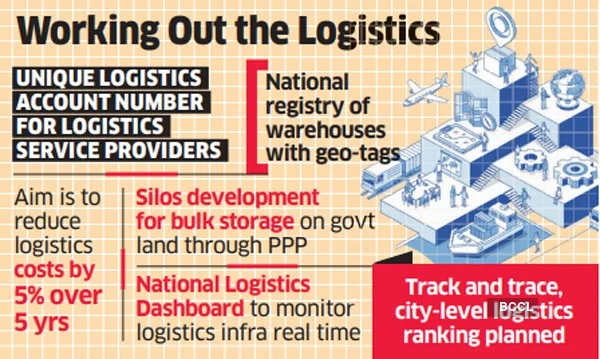Economics
In News: The Prime Minister launched the National Logistics Policy (NLP) at Vigyan Bhawan, New Delhi; a significant step in fulfilling the ‘Pran’ of India being a developed country.
India is the 5th largest economy in the world but the logistics cost is high at around 13-14%.
Under the policy a new digital platform Ease of logistics Services -E-Logs has also been started. Through this portal, industry associations can directly take up any such matters which are causing problems in their operations and performance with the government agencies.
About:
- The National Logistics Policy is an overarching interdisciplinary, cross-sectoral, and multi-jurisdictional framework for the development of the entire logistics ecosystem and will bring new energy to all sectors.
- Objective: To develop world-class modern infrastructure through the integration of all stakeholders in holistic planning and implementation so that efficiency and synergy are achieved in the execution of the project.
Need for logistics policy:
- High logistics costs in India as compared to other developed economies.
- To improve the competitiveness of Indian goods both in domestic as well as export markets.
- To improve efficiency cutting across various sectors of the economy, encouraging value addition and enterprise.
Steps to improve logistics sector:
- PM Gati Shakti – National Master Plan for muti-modal connectivity
- Unified Logistics Interface Platform or ULIP will bring all the digital services related with the transportation sector on a single portal, freeing the exporters from a host of very long and cumbersome processes.
- Increasing total capacity of Indian ports and the average turn-around time of container vessels, which has come down from 44 hours to 26 hours.
- For promoting export, 40 air cargo terminals have been constructed and 30 airports have been provided cold-storage facilities as well as 35 multimodal hubs are coming up in the country.
- Many new waterways are being built for eco-friendly and cost-effective transportation
- Kisan Rail and airports having the facility of Krishi Udaan have been constructed.
- Paperless EXIM trade process through e-sanchit and faceless assessment for customs
- Provisions for e-way bills, FASTag that have greatly increased the efficiency of the logistics sector.
- Unified tax system like GST in smoothening the issues of the logistics sector
- Change in drone policy and connecting it with the PLI scheme is promoting the use of drones in the logistics sector.
- Sagarmala, Bharatmala scheme and Dedicated Freight Corridors to improve logistics connectivity for systematic infrastructure development.
Benefits of the policy:

- National Logistics Policy has immense potential for development of infrastructure, expansion of business and increasing employment opportunities.
- Improve competitiveness
- Ensuring quick last mile delivery, end transport-related challenges, save time and money of the manufacturers, prevent wastage of the agro-products and improvement in coordination.
- Strengthening of the logistics sector will not only make the life of common man easier but will also help in increasing the respect of labour and workers.
- Issues related to logistics are reduced and when the country’s exports increase, small industries and the people working in them benefit the most.
Way forward
The PM said, “When parameters, roadmap and timeline for performance come together then policy plus performance equal to progress emerges”
The world is looking at India as a ‘democratic superpower’ and the ‘extraordinary talent ecosystem’ of India has impressed the field experts. Today the world’s attitude towards India is changing for the better.
Source: Pib.Gov














